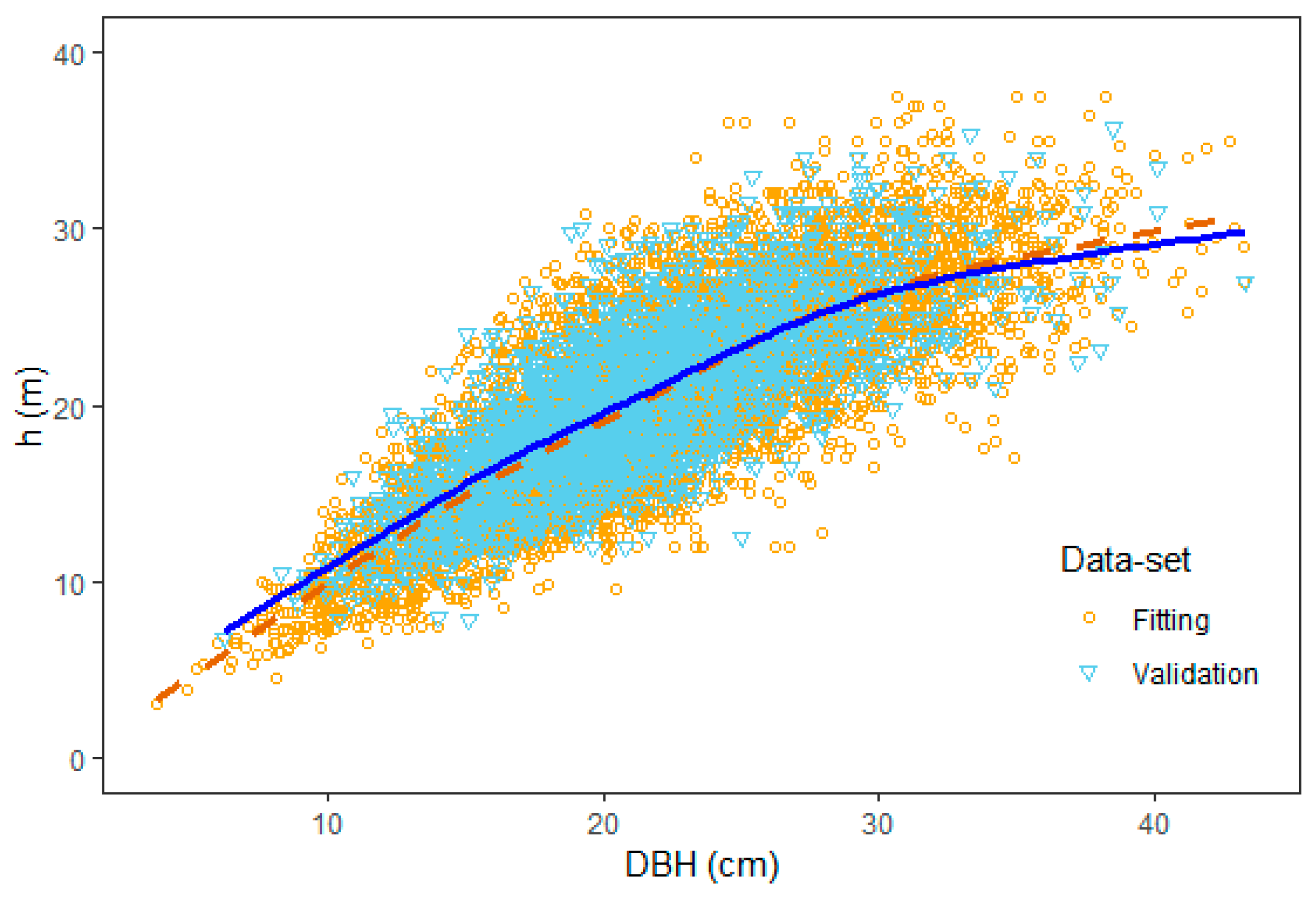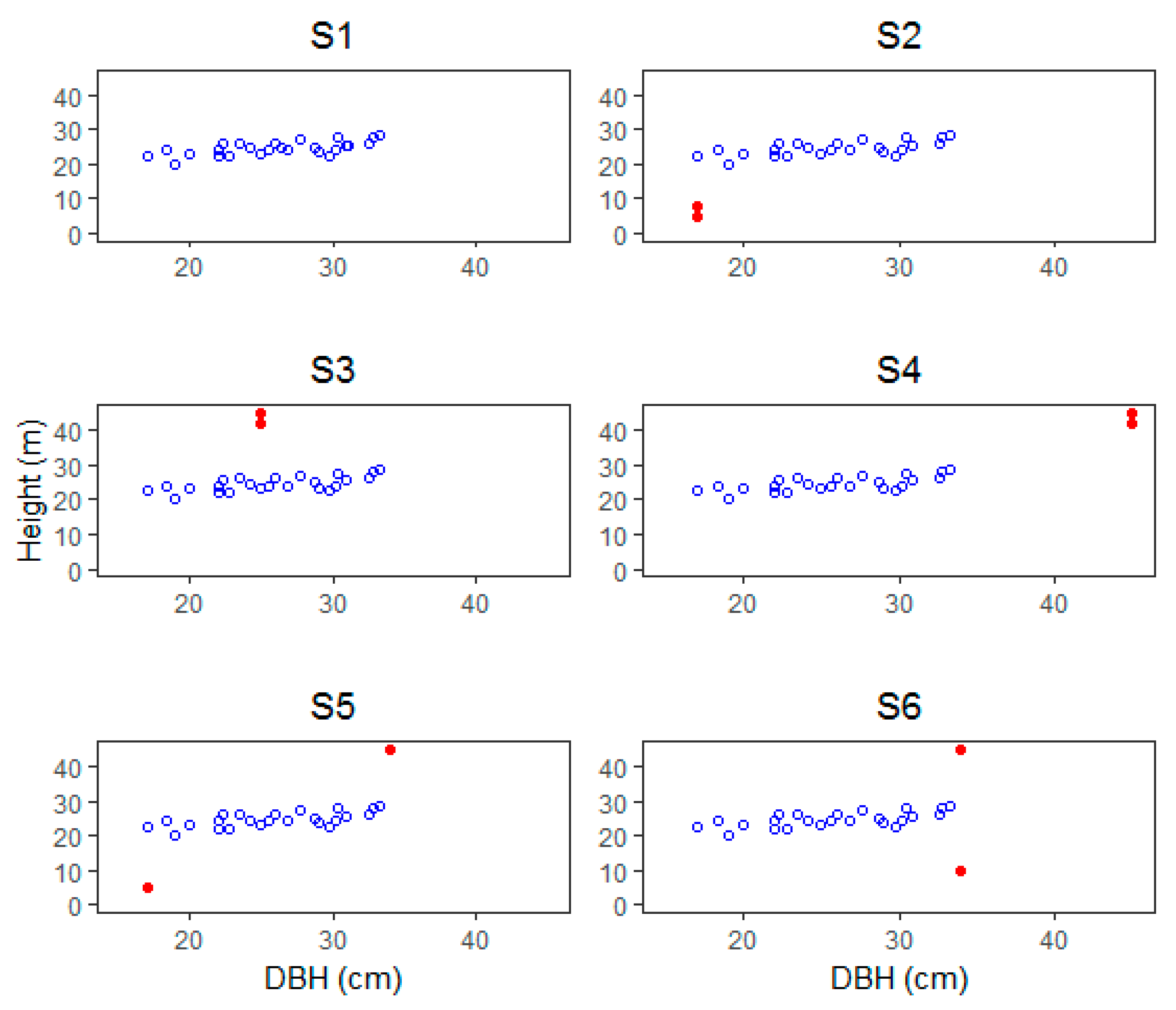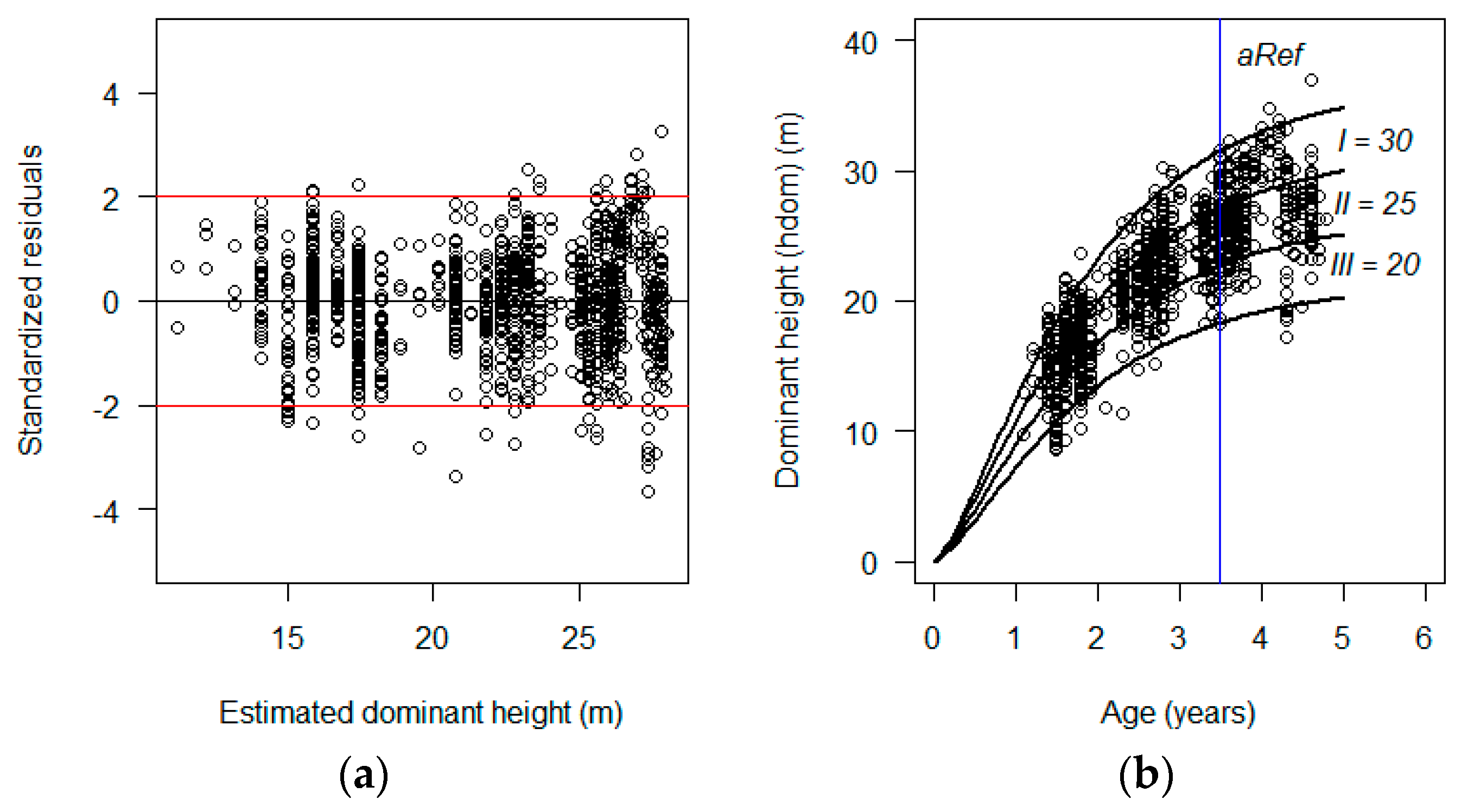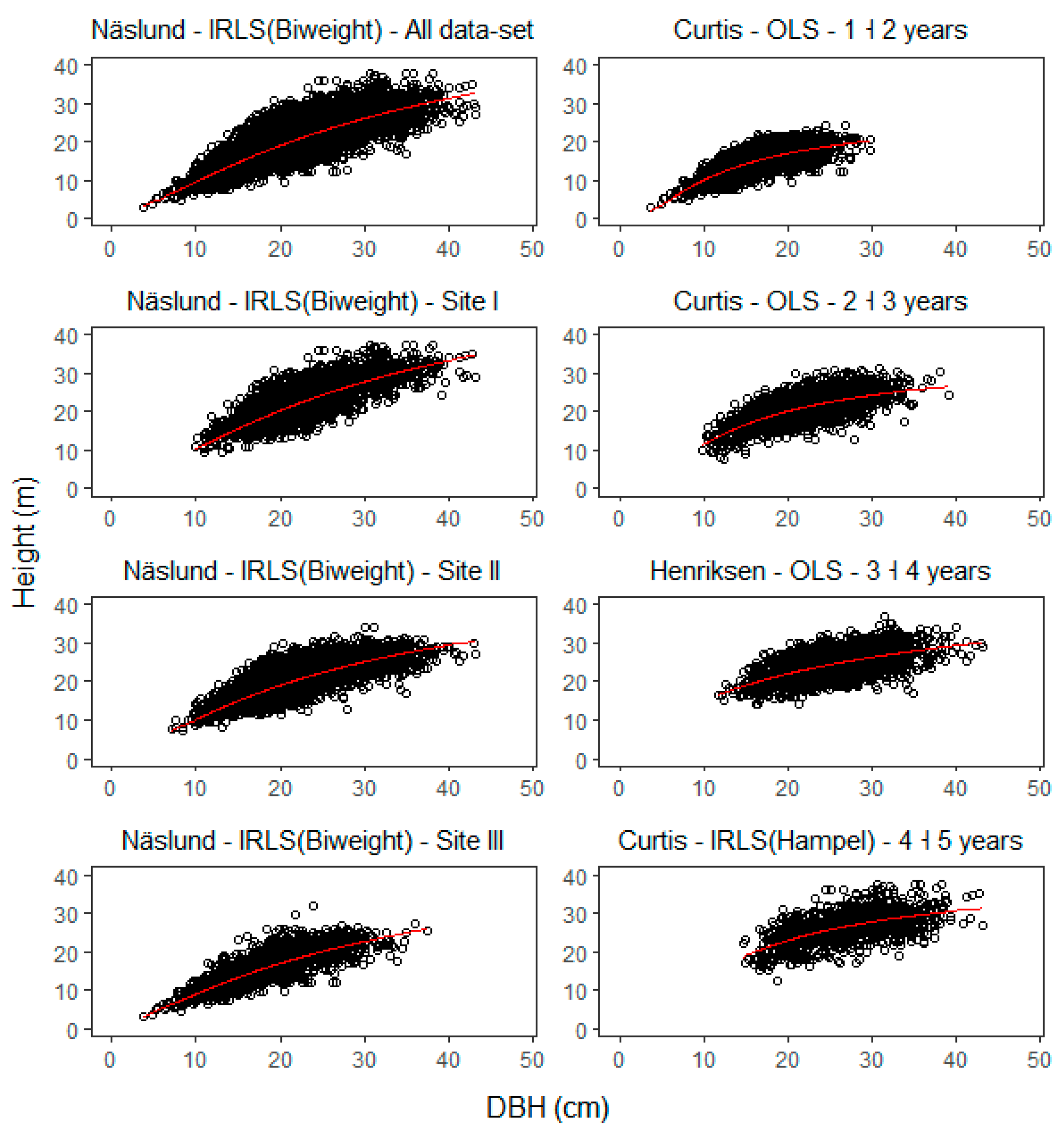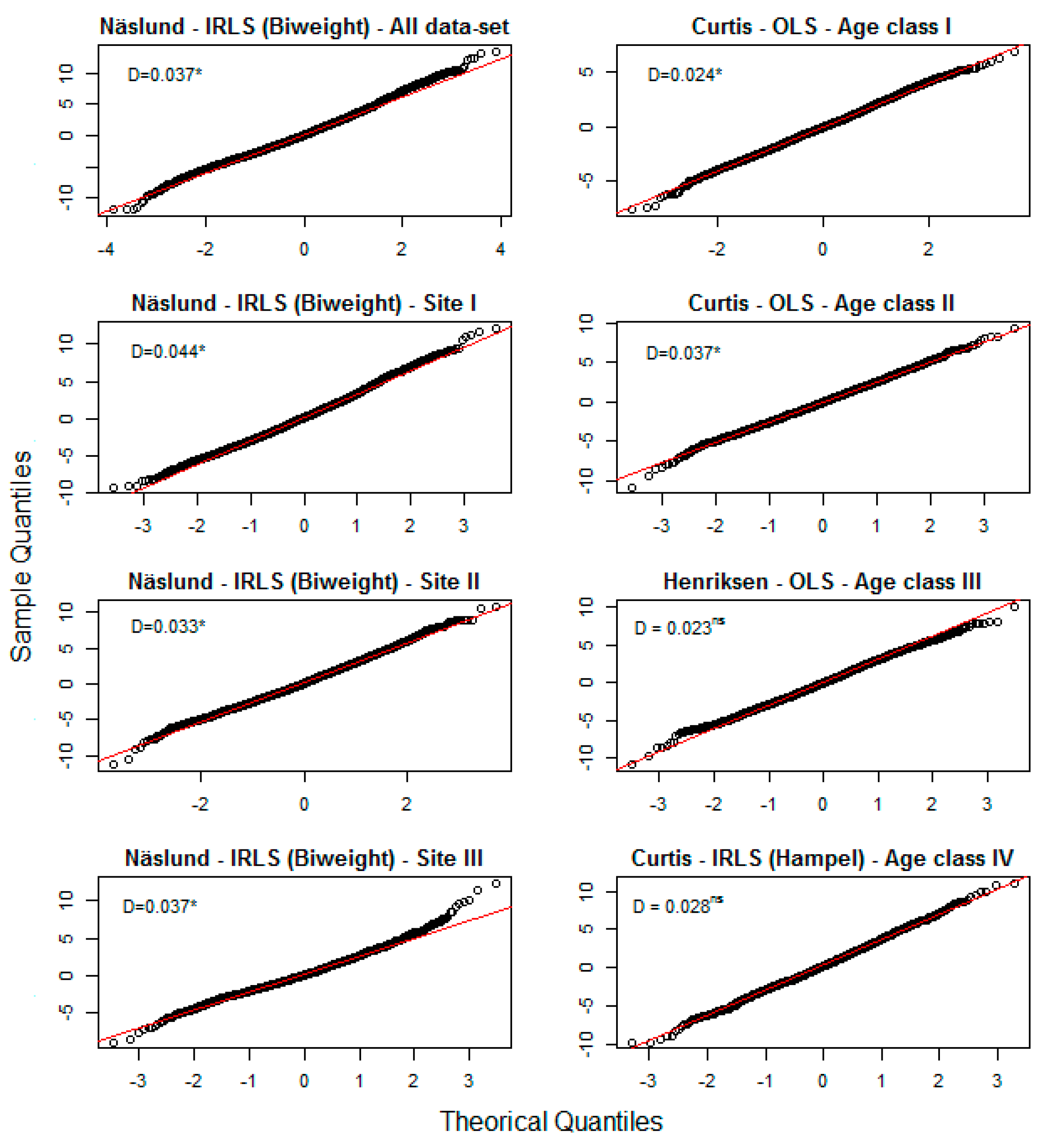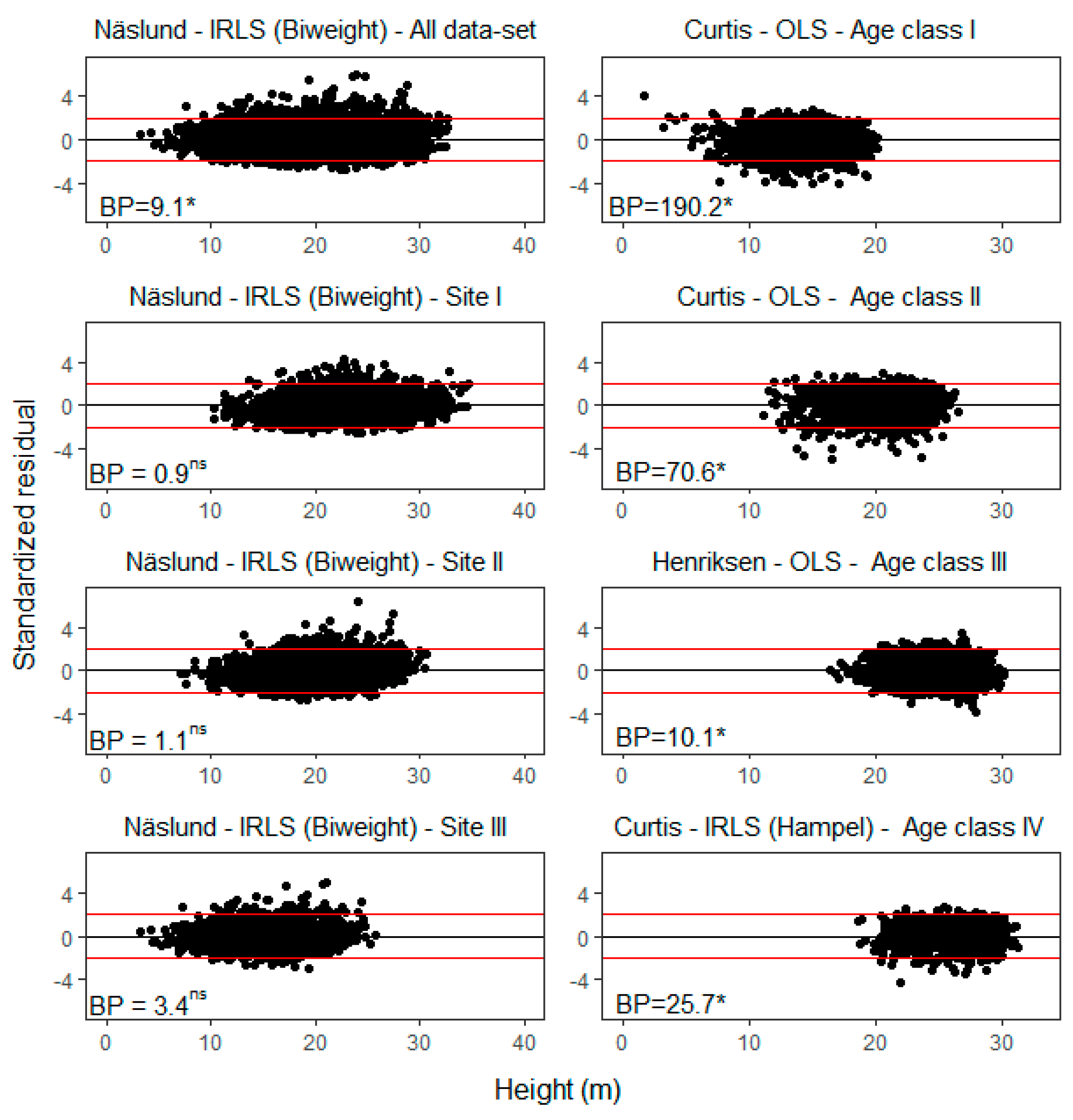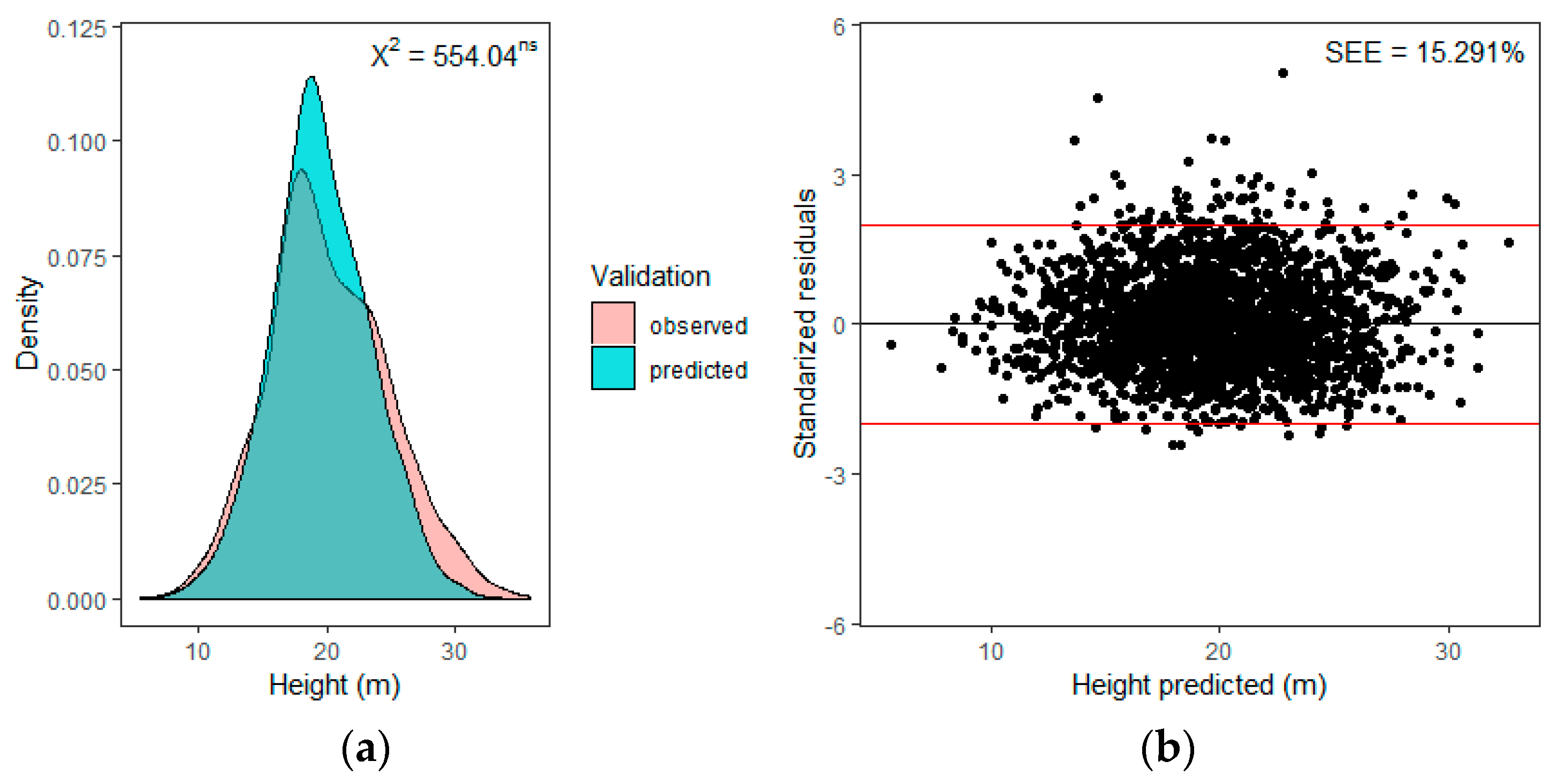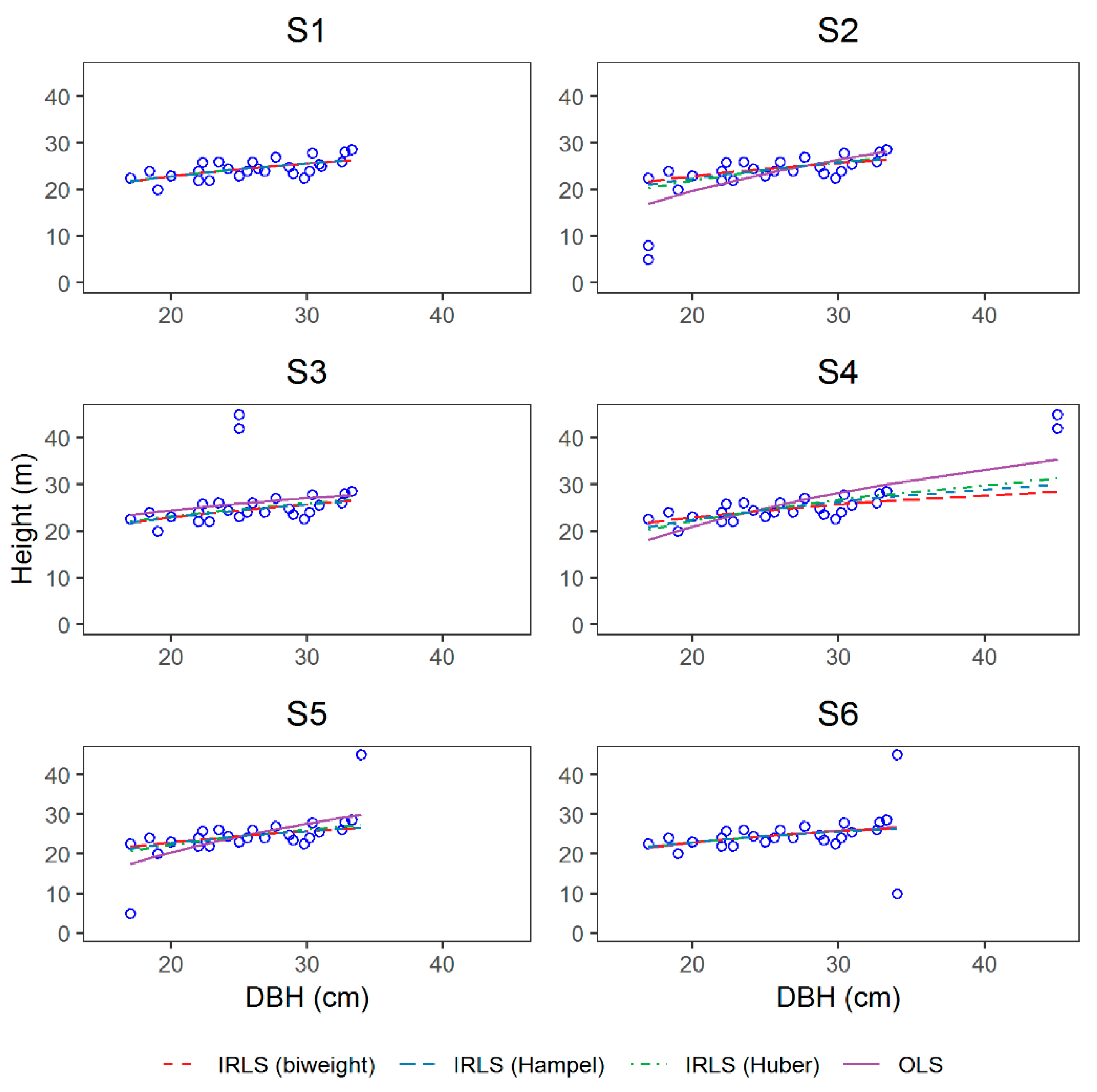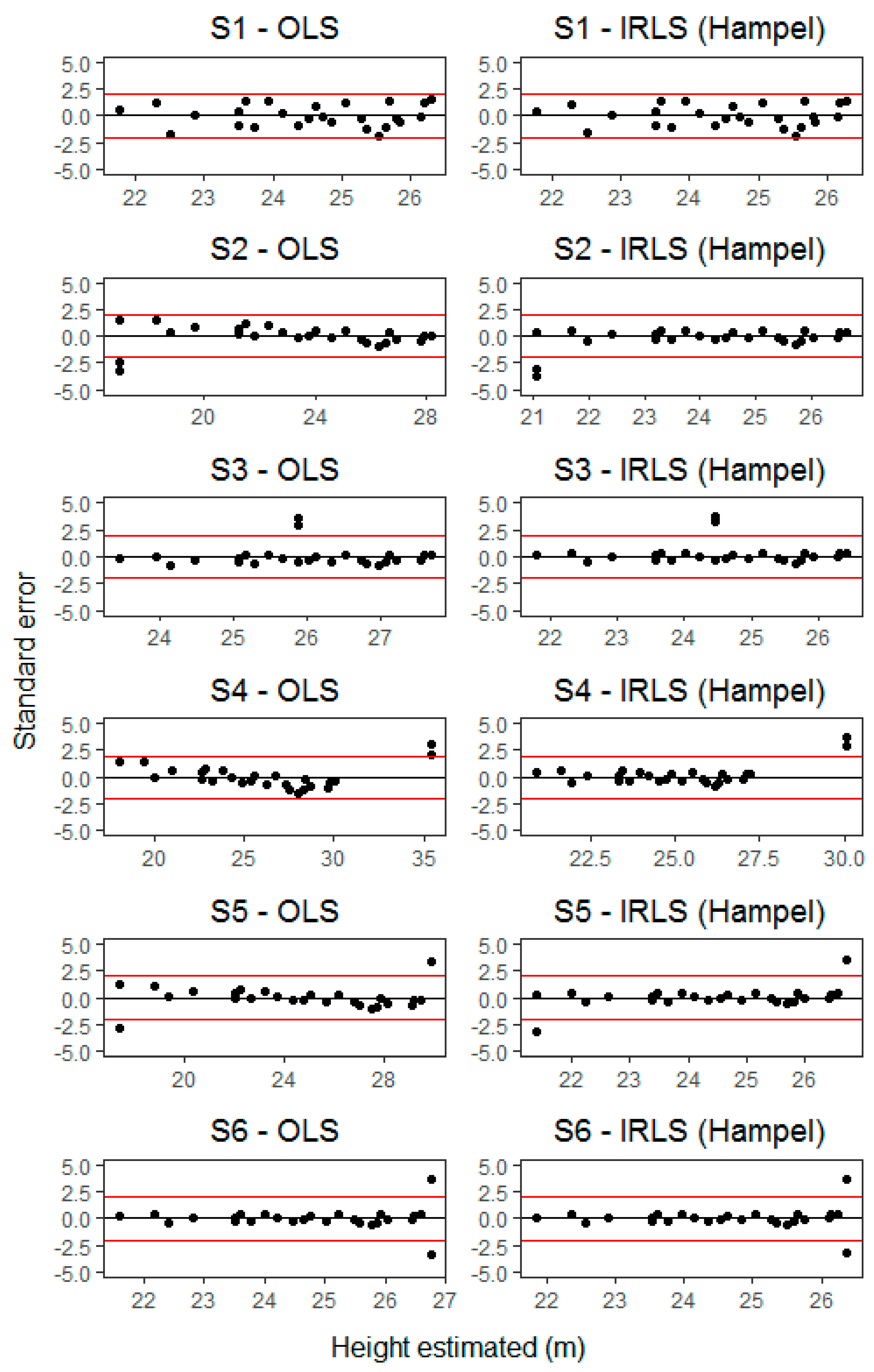1. Introduction
Ochroma pyramidale (Cav. ex. Lam.) Urb. (balsa-tree) is a large
Malvaceae pioneer tree species native from tropical forests. This species can reach 30–40 m in height, 60–120 cm in diameter at breast height (DBH), and crowns up to 40 m at the age of 15 years.
O. pyramidale is popularly known as balsa-tree and balsa-wood, with natural distribution throughout America, from southern Mexico to Bolivia, northern Brazil and the Antilles [
1,
2].
Due to its low weight (the density ranges between 0.06 and 0.38 g cm
−3) and mechanical resistance, the wood of
O. pyramidale is commonly used in wind turbine propellers, sports equipment, ships, and aircrafts [
3]. Balsa-wood has been in high demand on the international market, mainly Europe, China, and United States. Therefore, the species is planted in commercial reforestation programs and in mixed plantations to restorage degraded areas [
2,
4,
5].
This species is characterized by high growth rates and is managed in a clear-cutting and replanting system with harvesting of three- to five-year-old stands [
5,
6]. However, the fast growth contributes to considerable tree diameter and height variability in even-aged stands. The latter is largely due to high competition for water, light and nutrient resources among neighboring trees of similar age [
7]. Other important factors such as genetic characteristics, edaphoclimatic conditions, as well as forest management practices may contribute to growth variability; these also have been reported for
Eucalyptus spp. (eucalypts) stands, another species with high growth rates [
8].
Regarding the management of
O. pyramidale stands a lack of practical information exists about the behavior of height–diameter relationships on different site-index classes. The stand dynamics and individual tree characteristics are tightly linked to site-index conditions (local yield-capacity) [
9].
O. pyramidale stands management needs reliable information to assess its development [
5,
6].
The height–diameter relationship involves two very important variables in forest allometrics and modeling. This relationship is not only used to characterize the vertical structure but is also fundamental for many growth and production models [
10]. Due to the costs of measuring all tree heights, it is common to use statistical models to describe the height–diameter relationship [
6,
11,
12], which may be performed by site-index and/or age classes to improve predictions.
Ordinary least squares (OLS) is the most widely used estimation method for linear statistical models. However, this method is sensitive to outliers, in which a single atypical value may influence model fits and predictions [
13]. In this context and considering that
O. pyramidale data may present high variability, it is necessary to consider other regression methods that minimize the influence of outliers.
As concerns OLS regression methods, Montgomery et al. [
14] emphasize the importance of the distribution of values in relation to the independent variable. Namely, all values in a data-set are given equal weight, however, each value can affect the relationship between the dependent and the independent variables. That is, the slope of an OLS regression can be disproportionally influenced by extreme values of independent variables which are far from the point cloud (i.e., outliers). Given the above, our study is motivated by the need for improved tree height predictions for
O. pyramidale given the high probability of outlier occurrence.
The use of robust regressions is widely known to mitigate the influence of outlier observations [
15]. The approach was first developed by Huber [
16] and improved by Hampel [
17] Rousseeuw [
18], Yohai [
19]; Yohai and Zamar [
20], Maronna and Yohai [
21], Aelst et al. [
22] among others. Over more than half a century of development, several robust estimators have been proposed: maximum likelihood estimator (M), maximum likelihood estimator modified (MM), generalized M-estimators (GM), least median of squares (LMS), least trimmed squares (LTS), scale estimator (S), generalized S-estimates (GS), and robust and efficient weighted least square estimator (REWLSE), each with their particular characteristics [
13,
15,
23]. Here we focus on M-estimators which are characterized by estimation procedures that use likelihood functions to minimize error [
16,
24].
The fit of the models by robust regression is performed by iteratively reweighted least squares (IRLS), in which weights are applied to the observations through minimization functions, aiming to reduce the influence of outliers, whose residuals do not meet the traditional linear regression assumptions, especially normality [
25,
26].
Our study uses a large Ecuadorian data-set of O. pyramidale stands (containing outliers; n = 32,279 trees), in order to compare the performance of OLS and IRLS—when modeling height–diameter relationships. We assess model fitness and validate results using a split-sampling strategy. The overall aim is to derive best-modeling-practices to inform researchers and practitioners.
The specific objectives of our study are to: (i) model height–diameter relationship of Ochroma pyramidale stands from Ecuador by site-index and age classes; (ii) compare the model performance of the regression methods using OLS and IRLS with robust M-estimators, by (iii) employing large data-sets for model fitting and validation (Approach 1) and a smaller data-set representing six outlier scenarios (Approach 2), and (iv) examine the result consistency of performed comparisons by the adjusted determination coefficient, the standard error of estimate (SEE%), and graphical residual analysis. We test the hypothesis that robust regressions provide greater accuracy of height–diameter models than OLS by site-index and age classes in O. pyramidale stands.
4. Discussion
According to the site-index results for
O. pyramidale evaluated in Approach 1, the Chapman–Richards model was the most representative for h
dom predicted, although it showed a slight tendency to underestimate at the lowest heights and overestimate at the highest (
Figure 4a). Because it is a non-linear biological model with three parameters, it is very flexible and can properly represent the growth of an allometric variable like h
dom over time [
5,
39,
41].
Based on the result of R
2adj. (0.709) of the Chapman–Richards fitted model, it is possible to state that, in
O. pyramidale stands, the independent variable (age) explained the behavior of the dependent variable (h
dom) very well. On the other hand, regarding the SEE% (12.71%), although it can be considered high (>10%) [
42]), the result was satisfactory for the estimation of h
dom in the context of the variability presented by the data (overall cv% 24.3%,
Table 2).
It was observed that h
dom amplitude over age was greater than 10 m (
Figure 4b), which proves to be a feature of the development of
O. pyramidale, especially when seminally propagated, in which there is greater genetic variability [
43]. Our study does not control for this type of variability in growth; we note that this is a limitation in our study which could influence the way we classified plots in terms of site-index.
Since the site-index curves from
Figure 4b do not include all observations, our site-index classification, pertaining to intervals upper-class I and lower-class III, may have been ‘kept open’—as described by Cañadas-López et al. [
5].
Through site-index classification, it was possible to group the plots of the study into three productivity classes, with approximately half of them allocated to the intermediate class and the others to the lower and upper classes. This allowed for reducing the variability of observations by class and improving height–diameter predictions. The dominant height of
O. pyramidale is closely related to the site-index, as with other species [
10,
44]. Future work is suggested related to the effects of site-quality, which ideally ought to also account for the effects of climate, soil and forest management.
Results from Approach 1 suggest that DBH growth and h of
O. pyramidale is related to site-index and age classes (
Figure 5). Our findings also suggest that models that do not stratify are out-performed by models that stratified by age—these results were consistent in both OLS and IRLS. The above provides evidence of a relationship between data variability and fit performance; namely, models that do not stratify and models that only stratify by site-index appear to display a higher percentages of variation (i.e., cv%; see
Table 1).
Our results (
Table 6) also show better performance in models fitted by IRLS (e.g., Näslund; using Biweight)—this result appears consistent in models that do not stratify and those that only stratify by site-index. These results using the Näslund model are consistent with other empirical studies e.g., [
45], which suggests a certain flexibility of this model to describe the height–diameter relationships; namely, the mathematical design of this model appears to allow for better residual distribution—when evaluated directly from a linear model fit that does not isolate for the influence of the variable h (
Figure 7).
The higher accuracy of IRLS predictions of data with greater variability is due to the application of lower weights to outliers, minimizing error and improving the quality of fit [
24,
26,
46]. This result appears to be supported by models that stratify for site-index classes and those that do not stratify; namely, these two model specifications appear to exhibit greater variability for h and DBH (cv% >20%,
Table 1)—this suggests a relative gain in accuracy (SEE%) when compared to models that stratify by site and age classes (
Table 6).
In contrast, the gain in accuracy of OLS models that stratify by age classes appears to be partially explained by the better compliance of regression assumptions and lower variability for h and DBH (cv% <20% in most cases,
Table 1). In fact, when the linear regression assumptions are fulfilled, the OLS method enables more accurate predictions than robust estimators [
15,
18,
20,
22].
A desirable feature when fitting linear models is the smallest parameter standard error.
Table 7, shows for Approach 1 that, in this regard, both fitting methods presented less than 3% difference when analyzing the standard errors in the different classes of site-index and age. This suggests, a priori, that the performance of the four models adjusted by OLS and IRLS is very similar and this reflects the results in SEE% and R
2adj. that had little difference.
Regarding the apparent violation, in some cases, of the normality assumption, it was demonstrated for Approach 1 that the residuals of the fitted models follow the typical behavior of a normal distribution (
Figure 6) and this proves that OLS performs best in most age classes. On the other hand, robust regression has the characteristic that it can be used even when there is violation of regression assumptions [
18,
20,
22,
25,
26].
The distribution of standardized residuals (
Figure 7) appears to be related to data variability (this result was found in both in DBH and h). This variability seems to account for a portion of bias in the predictions of the height–diameter relationship; this was identified in particular in models that models stratified by age. We note that these models included several observations that were considered outliers (i.e., values with magnitudes greater than 2 standard deviations).
In Approach 2, there was also a similar result of SEE% and R
2adj. for the Henriksen model adjusted by both methods in the six scenarios evaluated; however, the IRLS (Hampel estimator) technique allowed a decrease in the parameters standard error from 43.38%–67.41% (
Table 9) compared to OLS in extreme scenarios (S2–S6).
Previous results suggest that, although important, the R2adj. and SEE% statistics are not appropriate to compare OLS and IRLS methods with robust M-estimators. The parameter standard error is appropriate to compare the methods since it is directly related to the confidence interval of the predictions, and consequently to the efficiency of the model, which is something that actually differs in the fitting of the two methods.
M-estimators are resistant to outliers in the dependent variable but are sensitive to the high number of leverage points in the independent variable [
13]. In this sense and based on the results obtained for Approach 1 by the three M-estimators tested, it was found that the data-set used in modeling the height–diameter relationship by site-index and age classes presents some variation with some possible outliers in both dependent variable h and independent variable DBH (
Table 1). This characteristic of the data-set conditions the efficiency of the M-estimators.
Outliers that do not relate to data collection errors should not be removed from the analysis [
47]. When outliers are present, robust regression is indicated due to its similar precision with the least squares method; however, the robust regression can decrease the parameter standard error, as demonstrated in the present study and which is directly related to the confidence interval of the predictions. However, in the absence of outliers the loss of efficiency of robust estimators compared to the OLS can be a maximum of 5% [
13,
18,
20].
5. Conclusions
Approach 1 of this study demonstrates the improvements in the modeling of height–diameter relationships, by site-index and age-classes, using a large sample of forest inventory plots in O. pyramidale stands in five Ecuadorian provinces (n = 9348); our findings suggest that non-stratified models are out-performed by models stratified by age-classes. The results suggest consistent performance improvements when using robust regressions with iteratively reweighted least squares—as compared to OLS. Notwithstanding this, we note that there is no single model that represents all the different site-index and age classes, since development in diameter at breast height and total height of this species features high variability over time. In Approach 2, we use a sub-sample of sample tree data (n = 26) to engage in a sensitivity analysis which indicates that IRLS decreases the standard error of regression parameters and improves the confidence of the predicted values.
Robust regression with the M-estimators for models fitted by iteratively weighted least-squares can improve more accurate predictions of the total height of O. pyramidale relative to the ordinary least squares method; these were particularly noted when comparing models which failed past tests of classical linear assumptions, as well as those with a cv% that is greater than 20%.
Furthermore, the performance comparison of the fitted models by both methods, based on the adjusted determination coefficient (R2adj.) and standard error of estimate in percent (SEE%), is not consistent since the results with outliers do not show a clear trend. Thus, the efficiency of these methods can be better analyzed based on the standard errors of regression parameters and the graphic distribution of the residuals.
In summary, the results of this study are timely, given that many practitioners and researchers in the private sector typically use OLS to analyze a relatively small forest operation (i.e., relatively small number of plots). Given the results of this study, we advise researchers who are interested in analyzing data with high variability (particularly those using a relatively small sample size) to consider the benefits of improving estimations using robust methods; namely, our results using large data-sets (i.e., Approach 1) appear to indicate performance parity of robust methods to OLS, whereas Approach 2 shows evidence of performance improvements in the presence of outliers and in smaller data-sets.
